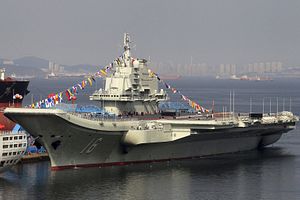On Thursday, the Chinese People’s Liberation Army-Navy (PLAN) conducted a live-fire drill in the Bohai Sea. According to Xinhua, China’s state news agency, the exercise involved “a large fleet of naval vessels and aircraft including aircraft carrier Liaoning.”
“In formation with several destroyers and frigates, the Liaoning carried out training in reconnaissance and early warning systems, air interception, sea assault, air-defense and anti-missile exercises,” Xinhua added.
China’s carrier-based Shenyang J-15 fighters, based on the Soviet-era Sukhoi Su-33, participated in the exercise as well. “Carrying live ammunition, several batches of J-15 carrier-based aircraft had performed strike exercises,” Xinhua noted.
Citing Chinese naval sources, Xinhua noted that the exercise was “part of the aircraft carrier’s overall test and trial” and “examined weaponry functions and training quality.”
Thursday’s drills were the first to incorporate the Liaoning since the carrier was declared “combat-ready.”
China commissioned the PLAN Liaoning, its first aircraft carrier, into the PLAN Surface Force in late-2012. The vessel is currently in active service, but its use is limited owing to the technical complexity of operating an aircraft carrier.
Given China’s inexperience in carrier operations and carrier aviation in particular, training exercises with the Liaoning are a critical part of the PLAN’s human resource development to enable future carrier operations.
Some observers and analysts of the Chinese Navy in the west regard the Liaoning — a refurbished and retrofitted Admiral Kuznetsov-class Soviet Navy carrier — as a training carrier for the PLAN ahead of China’s plans to launch indigenously designed and built carriers.
Earlier this year, the Chinese Defense Ministry confirmed that construction is underway on Beijing’s first home-made carrier at Dalian. The new carrier is expected to displace around 50,000 tonnes.
As I discussed this summer, China’s second carrier could enter sea trials in early 2017. In the meantime, giving PLAN personnel as much transferable carrier operations experience aboard the Liaoning will be valuable.
This may apply particularly to managing the Liaoning and upcoming carrier’s air wing. Both carriers feature a more primitive ski-jump flight deck, allowing for short take-off but arrested recovery (STOBAR) operations.
Beijing’s future carriers, however, may feature more advanced catapult assisted take-off but arrested recovery (CATOBAR) launch system, allowing for faster sortie rates and less stress on airframes for its J-15 and eventually J-31 carrier-based fighters. (Beijing started flight testing a J-15 variant with a modified nose wheel enabling CATOBAR operations earlier this year.)
China’s 2015 defense white paper emphasized the importance of an expeditionary, global role for the Chinese military:
It is necessary for China to develop a modern maritime military force structure commensurate with its national security and development interests, safeguard its national sovereignty and maritime rights and interests, protect the security of strategic SLOCs and overseas interests, and participate in international maritime cooperation[…]
China also established its first overseas military base in Djibouti earlier this year, with the base potentially playing an important role in enabling PLAN anti-piracy operations in the Gulf of Aden and off the coast of Somalia in the Indian Ocean.

































